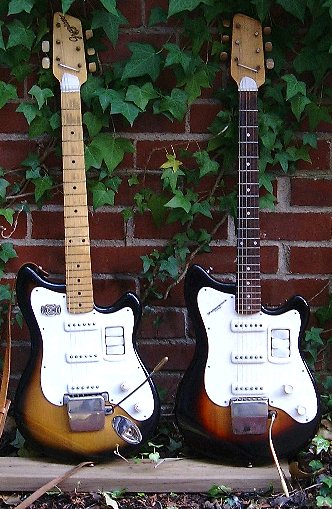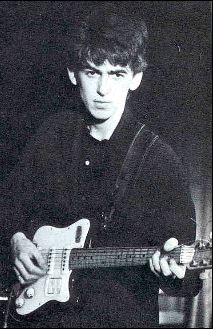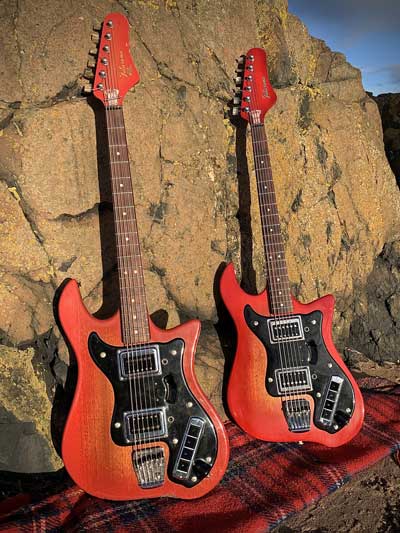


Resonet Grazioso and Futurama III
courtesy of Dusan Palka,
California, USA.
No, Futurama guitars were not made
by Hofner. They were not even made in Germany. So why a page about them
on a Hofner based website? Well..., they were brought into the UK by
Selmer as an alternative to their Hofner range in the late 1950's and
1960's, they
were attractive, reasonable quality instruments by the standards of the
day,
they were priced at a level which could be afforded by UK guitarists,
and.....the Futurama III/Grazioso was arguably the most used individual
solid electric guitar in use by the UK's rock bands during those early
days before Messrs Fender and Gibson's products appeared in Britain!
The Futurama brand name, (because that is what it was - a
suitably eye-catching name given to imported instruments by Selmer),
was therefore a major feature in early British rock music history.

THE STORY SO FAR:
In very brief, and maybe not totally reliable, terms the story goes something like this:
|
Pages from Selmer 1959 Catalogue.
|
1. THE DREVOKOV RESONET GUITARSIn 1958/59, Selmer commenced the import of a three pickup solid guitar which was manufactured initially at Blatn in Czechoslovakia under the Trade name of Resonet by the huge Drevokov Co-operative, part of which made furniture and.....electric guitars!!) This guitar had the model name of "Grazioso" and was designed by a Mr Ruzicka who appears to have been the driving force behind all the Resonet guitars. (By the way, Resonet apparently means music played in a graceful, smooth, manner in Czechoslovakian.) No marketing man in the 50's could have lived with product titles like that for very long, so after a short period Selmer changed the name in their catalogue to Futurama. This guitar was the nearest thing to the Stratocaster that was available at that time in Europe, but at 55 guineas was just about affordable to the British. I don't suppose that it should come as any surprise that the Czechs actually gained their inspiration from a genuine Strat that they had imported from the States in 1955!
This very early version, called simply "Futurama" is the model that
George Harrison used. It is characterised by the natural finished maple or sometimes
beech (some later ones did in fact have rosewood) fingerboard, and the top-mounted jackplug
socket. A double sided headstock is fitted with three-on-a-plate
tuners, and the white scratchplate covers the majority of the body top.
Body material was either beech or maple.
But perhaps it was the electrics that resulted in the Futurama being
given the title "The Worlds Most Advanced Electric Guitar" in future Selmer
catalogues! Three pickups with individual "piano" type toggle switches
for every conceivable combination of pickup selections (7No.). Now that
certainly was more advanced than the Fender, which only had three
combinations in those days! And the tremolo mechanism was pretty
sophisticated too. Nothing else in the World,
bar the Strat's own trem unit could come near it for engineering
excellence, with its individual bridge saddle adjustment and rear
mounted springs acting on each string! During this period, Drevokov also supplied Selmer with the Resonet Electric Bass. This was a futuristic stand-up solid bass which proved quite popular due to the improved portability and sound volume of this compared to the traditional acoustic bass that was the norm up to the bass guitars becoming available in the UK. |
|
1959/1960 Futurama III
Page from Selmer 1960/61 Catalogue
Page from Selmer 1961/62 Catalogue
|
2. THE C.S.H.N. NEOTON/JOLANA GUITARS
In 1959, the original
Futurama Solid Guitar was replaced by a similar looking instrument that
Selmer called the Futurama III, which had a rosewood look-a-like
fingerboard (generally a dark stained beech) and a body-edge mounted
jackplug socket. The tremolo unit also changed from a two post system
to a
separate wood mounted bridge unit. The change to a dark fingerboard was
the most
visible change however. Now, wasn't it at about that time that Fender
went onto rosewood boards?
The Hradec
Kralove manufactured Futurama III was initially called the "Neoton Star
II" (or perhaps Star III)
initially in Czechoslovakia. The "Neoton" trade name was soon dropped
however, being replaced by the trade name of "Jolana" - probably after
the name of Mr Ruzickas's daughter !!
The Futurama II seems to have been finished in various sombre solid colours only; the more expensive sunburst was not available on this budget model. I have seen mauve and black finishes on Futurama IIs. A further change to the Futurama III occurred around late 1960, when the headstock was finally changed to single-sided, fitted with six individual open machine heads. The body finish generally remained as sunburst, but I have had a report of a red finish Futurama III of this type being purchased new in early 1962, so perhaps two of the Czech finishes were made available in the UK, or the red models were a transition towards the third version described below, which I believe appeared in 1963. Talking of headstocks, these would appear to have been produced to the same shape as on the Telecaster, and not as shown in the Selmer catalogue. Maybe the catalogue guitar was a prototype, or perhaps Selmer simple got an artist to alter an illustration of one of the previous 3-a-side headstock guitars. Certainly, picture "doctoring" was used on some of the Hofner guitar pictures in the catalogue.
The II's headstock also went
single-sided, but the light coloured
"maple" fingerboard was retained for a little longer, before finally
reverting to
"rosewood" in 1963 when the whole guitar got a re-vamp (see below). The
original large chrome capped control knobs on the II seemed to have
decreased in diameter
around about 1961.
|
|
Page from Selmer 1963 Catalogue
Page from Selmer 1965 Catalogue |
3. THE C.S.H.N. JOLANA GUITARS - 2nd SERIESThe first big upset
in the Futurama success story occurred in 1962. The Futurama IIIs
appearing in the catalogues and shops at this time, at first glance
seemed to be the same apart from a change in finish from sunburst to
red/orange, but closer inspection revealed that something else had
radically changed. The scratchplate had been reduced in size, and the
plastic did not seem to be the same as the original sunburst versions.
The headstock had suddenly become pointed in shape. The pickups had now
taken on a cheap appearance with chromed plates, probably to facilitate
adjustable pole pieces. The body did not have the same feel about it,
particularly with the "comfort-contouring" now very apparent. What was
going on? Al though rosewood fingerboards were normally fitted to the Futurama III of this era, I have heard of at least one that has a natural maple- looking board. Oh! The Futurama II got a bright red finish also, together with a new rotary pickup selector close to the lower cutaway. This was fitted with a funny little handle presumably to aid speed of use. The previous very crude tremolo unit was replaced with something which looked slightly more sophisticated, and the shape of the scratchplate was changed. It continued to be featured in the Selmer catalogue in this format for a couple of years after the Futurama III had been replaced by the Hagstrom-made guitars (see below). However, it's name was changed to "Futurama Duo", presumably to allow the Futurama 2 and 3 titles to be available for the Hagstrom models. The Duo finally seems to have been discontinued (at least as far as Selmer were concerned) around about 1965. Competition in the UK was now much more fierce than in the Fut's early days. Quite apart from the American guitars for the top-flight guitarists, there was now the new Hofner Galaxie with its myriad of switches, the Watkins Rapier which if nothing else looked the business, and what about those beautiful Burns guitars which certainly were the business! Even Selmer themselves decided to up the quality stakes with the Futurama name, and introduced Swedish Hagstrom-made guitars to their catalogue in May 1963 which sold under the Futurama banner. The red Czech-built Futurama III soldiered on for a few more months after that, and then quietly disappeared from the music stores of the UK.
|
|
Pages from the 1964 Selmer Catalogue.
|
4. THE HAGSTROM-MADE FUTURAMA DELUXE
|
|
|
5. THE HAGSTROM-MADE FUTURAMA CORONADOFinally, a more up-market trio of guitar, bass guitar, and six string bass was introduced under the overall model name of Futurama Coronado, Again produced by Hagstrom and based upon the existing Hagstrom Coronado Bass, these ran in parallel in the UK with the De Luxe series above. The Coronados really went to town with the numbers of futuristic switches used to control their electrics. In addition, the "King's neck" on the Coronado Automatic six string guitar was fitted with an Acrylite synthetic fingerboard, claimed to be "warp-proof and impervious to perspiration", and stainless steel frets. Come back Grazioso, all is forgiven.......! |
|
The Futurama brand name continued into the second half of the 1960's on the Hagstrom instruments, (and also on a pair of budget priced guitars called the Freshman and the Sophomore), gently fading away together with the Selmer Hofner line as the Japanese imports cleaned up what was left after the US instruments invasion of the UK. Futurama guitars were always intended to be a slightly down-market alternative to Hofner in the Selmer catalogue, just as the Futurama amps were the budget alternative to the Selmer Truvoice amps. However, the sunburst Grazioso/Futurama III deserves a far higher recognition than that. It must be considered to be of at least similar status to the Hofner Club, Senator, and President guitars in the vintage guitar hall of fame.
|
|

Two lovely old Futurama/Hagstrom 6-String Coronado Basses, owned by Matt Armstrong
If you wish to learn more about Czech guitars, the JOLANA WEBSITE run by Vladimir Zak is the one for you, and there is now an English translation!
Also, many thanks to Simon Murphy for his help on the Hagstrom Futuramas, and Laszlo for the Freshman and Sophomore catalogue scan.